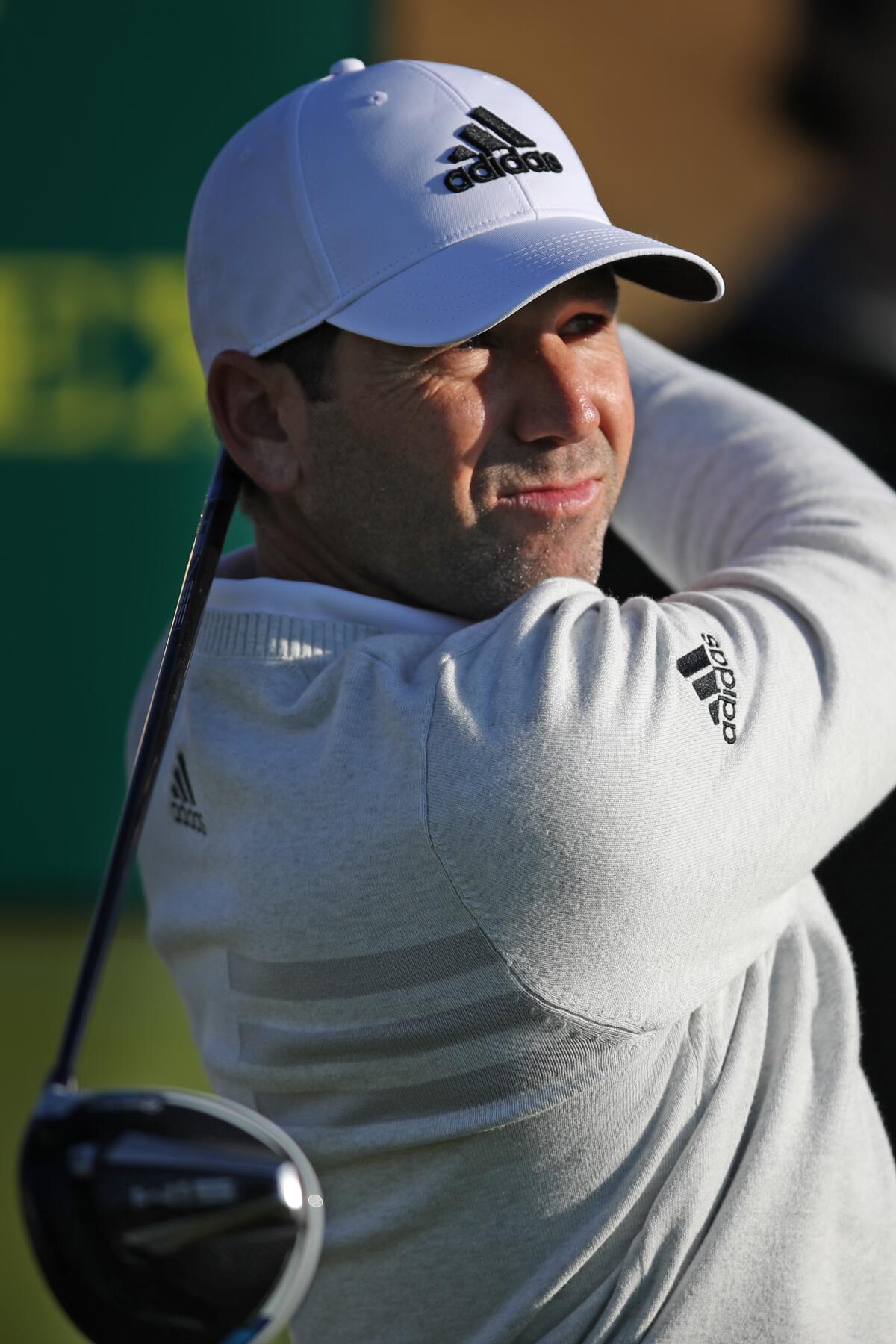Genesis Invitational opens discussion of players hitting ball too long for courses

- Share via
It wasn’t long ago when golfers such as Fred Couples would unleash a three-wood and reach the green in two on the 590-yard 17th hole at Riviera Country Club causing the gallery to roar at the rare display of raw power.
As the world’s best players tee off Thursday in the opening round of the Genesis Invitational in Pacific Palisades, going for the green on a second shot on that hole — and on most par fives almost every week of the PGA Tour season — has become more the norm than the exception.
Golf balls are coming off the club faster, staying in the air longer and coming down in places unheard of a generation ago.
That distance has the gatekeepers of golf in lockdown mode.
In early February, the United States Golf Assn. and the Royal & Ancient Golf Club — the governing bodies of the sport — released a comprehensive report detailing the almost annual increased distances players have been hitting the ball over the last century. Without offering solutions, the Distance Insights Project was clear on one point: The ball, specifically on the elite level, is simply going too far.
Tiger Woods hasn’t played regularly at Riviera Country Club, which is partly the reason he’s never won here. He aims to fix that this week at the Genesis Invitational.
Said R&A chief executive Martin Slumbers:
“Our research shows that hitting distances and the lengths of golf courses have been increasing for more than a hundred years. This is not just a phenomena of the last few decades. These changes have been driven by equipment innovation, improved course conditions and player athleticism. We believe that this continuing cycle of increases is undesirable and detrimental to golf’s long-term future.”
The concerns are multifaceted: Courses need to be longer to accommodate increased distances, meaning greater expense in building and maintaining them, and strategy that is such an important part of course design is diminished because players can bypass dangers that no longer come into play.
From one of the many charts in the report: The average driving distance on the PGA Tour has increased from 256 yards in 1980 to 296 in 2018. The increase for midlevel handicappers in that time has been much more modest, from about 186 yards to 200.
The USGA and R&A said they would provide a list of areas for research on the topic within 45 days, and then the prolonged discussions involving all areas of the game — players, architects, organizations, manufacturers — would ultimately result in some sort of resolution a year or so away.
Although many, perhaps most, tour players don’t see a need for change, Tiger Woods, world No. 1 Rory McIlroy and Jack Nicklaus are among prominent names in golf who have publicly said they think something needs to be done to rein in distances. But as discussions with several of the players in an elite field at the tournament benefiting Woods’ TGR Foundation would indicate, resolution could be elusive.
One possible solution that the report referred to involves separate equipment rules for elite competition.
McIlroy, who complained recently on his Instagram account that the distances players were hitting the ball were taking strategy out of the game, has no issue with dialing things back for the game’s uppermost tier. This is coming from a guy with an average driving distance of 312 yards.
“I think the biggest thing that came out of the report for me, a lot of the stuff about the ball going too far and technology, it really pertains to 0.1% of the golfers out there,” he said Wednesday at Riviera.
“So, look, if they want to try to contain what we do as touring professionals, I’m all for that.”
There’s hardly a consensus on that point.
“It’s a fine line,” tour veteran Steve Stricker said. “One of the coolest things about our sport is that you are playing basically the same equipment we are and on the same courses. I’d hate for us to go to a whole separate set of rules and equipment than the general public. ...
“So, could we stop it right now and be in a good place? We probably could.”
Tony Finau, whose average drive of just more than 310 yards ranks 20th on the tour this season, is another player who likes things as they are.
“l hope it doesn’t end in them going to a limited-flight ball,” he said as he walked toward his pin-high tee shot just to the left of the 315-yard par-four 10th hole in the pro-am Wednesday.
“You can’t penalize guys who have gained a skill of hitting it far. ... The way to make the game harder is to make courses really tight, with fast greens and high rough. If the rough was more penalizing every week, that stat they’re after would be a lot lower.”

Woods, once one of the longest hitters, said that a separate set of rules for the top level is “certainly” going to be part of the discussion, adding that it’s important to keep the game fun for average golfers.
“We want to keep the game enjoyable, keep having more kids come play it,” he said.
“When I first came out here, if you carried [your driver] 270, it took a lot of trouble out of play. Now guys are hitting their hybrids and five 5-woods 270 in the air.”
Casey O’Callaghan, a course architect based in Costa Mesa, has seen first-hand how new courses have to reflect new distances.
“Courses just get longer and longer,” he said. “If you look at some of the classic courses, they’ve had to stretch them out. Not everyone can do that. At Augusta, they bought land from Augusta Country Club just so they could stretch out the 13th tee. ...
“I’m very happy they came out with this study.”
McIlroy also mentioned the environmental responsibility implicit in the report.
“Building these golf courses on these massive pieces of land, having to use so much water, so much fertilizer, pesticides, all the stuff that we really shouldn’t be doing nowadays, especially in the climate we live in. ...
“I think golf has a responsibility to minimize its footprint as much as it possibly can.”
More to Read
Go beyond the scoreboard
Get the latest on L.A.'s teams in the daily Sports Report newsletter.
You may occasionally receive promotional content from the Los Angeles Times.











